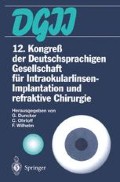Zusammenfassung
Die unspezifische Therapie der Entzündungsreaktion nach Phakoemulsifikation und Hinterkammerlinsenimplantation beginnt in der Regel am Operationsende. Es sollte abgeklärt werden, ob die ergänzende präoperative Steroidgabe von klinischer Relevanz ist. In einer randomisierten, prospektiven Einfachblindstudie wurden 60 Patienten (42–85 Jahre) mit einer altersabhängigen Katarakt operiert und perioperativ mit Prednisolon-0,5% -Augengel behandelt.
Prednisolon Gel-Applikation: Gruppe A (n=31): 4mal präoperativ innerhalb der letzten beiden Stunden, 2mal am Operationstag postoperativ, 3mal täglich vom 1.–10. postoperativen Tag;
Gruppe B (n=29): 2mal am Operationstag postoperativ, 3mal täglich vom 1.–10. postoperativen Tag.
Zielkriterien waren die Kammerwasserreaktion (Tyndallometrie) und die Hornhautquellung (Ultraschall-Pachymetrie).
Tyndallometrie der Augenvorderkammer:
Gruppe A: von durchschnittlich 10,03 ± 0,93 ph/ms (präoperativ) über 17,35 ± 1,68 ph/ms (1. postoperativer Tag) auf 13,38 ± 3,42 ph/ms (10. postoperativer Tag);
Gruppe B: von durchschnittlich 11,31 ± 1,48 ph/ms (präoperativ) über 21,99 ± 3,33 ph/ms (1. postoperativer Tag) auf 9,34 ± 1,21 ph/ms (10. postoperativer Tag).
Ultraschall-Pachymetrie der zentralen Hornhaut:
Gruppe A: von durchschnittlich 599 ± 7 µm (präoperativ) über 649 ± 20 µm (1. postoperativer Tag) auf 622 ± 24 µm (10. postoperativer Tag);
Gruppe B: von durchschnittlich 582 ± 17 µm (präoperativ) über 618 ± 11 µm (1. postoperativer Tag) auf 599 ± 17 µm (10. postoperativer Tag).
Das in veränderter Galenik verwandte Steroid zeigte eine deutliche antiinflammatorische Potenz. Es fand sich aber keine signifikant verstärkte Hemmung der perioperativen Entzündungsreaktion durch eine zusätzliche präoperative Prednisolon-Gel-Gabe.
Summary
Nonspecific antiinflammatory therapy after phacoemulsification and implantation of a posterior chamber lens starts immediately at the end of the operation.
We tried to find a clinical relevance for additional preoperative steroidapplication.
In a randomized, prospective single-masked study, 60 patients (age 42–85 years) with age related cataract were operated under perioperative administration of prednisolon 0.5% eye gel.
Prednisolon gel administration:
group A (n=31) – four times topical Steroid application within the last 2 h before surgery, two times after surgery on the same day, three times daily ist-ioth postoperative days;
group B (n=29) – two times after surgery on the same day, three times daily 1st-10th postoperative days.
Trial objectives were laser flare of the aqueous humor (tyndallometry) and change in central thickness of the Cornea (ultrasound pachymetry).
Laser flare of the aqueous humor:
group A (n=31) – from an average of 10.03 ± 0.93 ph/ms (preoperative) to 17.35 ± 1.68 ph/ms (1st postoperative day) and to 13.38 ± 3.42 ph/ms (10th postoperative day);
group B (n=29) – from an average of 11.31 ± 1.48 ph/ms (preoperative) to 21.99 ± 3.33 ph/ms (1st postoperative day) and to 9.34 ± 1.21 ph/ms (10th postoperative day).
Ultrasound pachymetry (corneal center):
group A (n=31) – from an average of 599 ± 7 µm (preoperative) to 649 ± 20 µm (1st postoperative day) and to 622 ± 24 µm (10th postoperative day);
group B (n=29) – from an average of 582 ± 7 µm (preoperative) to 618 ± 11 µm (1st postoperative day) and to 599 ± 17 µm (10th postoperative day).
The Steroid with the changed galena shows a pronounced antiinflammatory efficacy; there is, however, no further significant inhibition of perioperative inflammatory reaction by additional preoperative administration.
Access this chapter
Tax calculation will be finalised at checkout
Purchases are for personal use only
Preview
Unable to display preview. Download preview PDF.
Literatur
Diestelhorst M, Konen W, Aspacher F, Kriegelstein GK (1990) Protektiver Effekt unterschiedlicher Steroidderivate auf die Blut-Kammerwasser-Schranke in der Katarakt-Chirurgie. Z prakt Augenheilkd 11: 405–408
Diestelhorst M, Anspacher F, Konen W, Kriegelstein GK, Hilgers RD (1992) Der Effekt von Dexamethason-0,1%- und Prednisolon-i,o%-Augentropfen auf die Blut-Kammerwasser-Schranke. Ophthalmologe 89: 342–345
Hessemer V, Schartner H, Schmitt K (1995) Minimale chirurgische Entzündungsreaktion nach “Clear-corneal”-Phakoemulsifikation. In: Rocheis R et al. (Hrsg) 9. Kongreß der DGII. Springer, Berlin Heidelberg New York, S 34–40
Hessemer V, Schmitt K, Jacobi A (1996) Entzündungshemmende Effekte und Kammerwasserkonzentrationen verschiedener nichtsteroidaler Antiphlogistika bei extrakapsulärer Katarktchirurgie. Klin Mbl Augenheilk 208:161–166
McGhee et al. (1990) Penetration of synthetic corticosteroids into human aqueous humor. Eye 4: 526–530
Sawa M et al. (1988) New quantitative method to determine protein concentration and cell number in aqueous in vivo. Jpn J Ophthalmol 32:132–142
Shah SM, Spalton DJ, Smith SE (1991) Measurement of aqueous cells and flare in normal eyes. Br J Ophthalmol 75: 348–352
Strobel J, Seitz W, Tietze K (1991) Quantitative Untersuchungen von Protein- und Zellkonzentrationen in der Vorderkammer bei Kataraktchirurgie unter Therapie von steroidalen und nichtsteroidalen Antiphlogistika. Ophthalmologica 202: 86–93
Struck HG, Stoldt G (1997) Klinische und pharmakokinetische Untersuchungen zur perioperativen antiphlogistischen Wirksamkeit von Prednisolon-Gel bei der Kataraktextraktion. In: Ohrloff C et al. (Hrsg) 11. Kongreß der DGII. Springer, Berlin Heidelberg New York, S 401–407
Struck HG, Stoldt G (1997) The antiinflammatory efficacy of prednisolone eye gel after cataract extraction. In: Süveges I, Follmann P (eds) Xlth Congress of the European Society of Ophthalmology. Editore Monduzzi, Bologna, S 245–251
Struck HG, Schäfer K, Foja C, Giessler C (1993) Zur Bedeutung der Operationstechnik für die Entzündungsreaktion bei der Katarakt-Extraktion: In: Robert YCA, Gloor B, Hartmann Ch, Rocheis R (Hrsg) 7. Kongreß der DGII. Springer, Berlin Heidelberg New York, S 338–343
Editor information
Editors and Affiliations
Rights and permissions
Copyright information
© 1999 Springer-Verlag Berlin Heidelberg
About this paper
Cite this paper
Luther, M., Struck, H.G., Lautenschläger, C. (1999). Zum klinischen Effekt präoperativer Steroidgaben auf die Entzündungsreaktion nach der Kataraktoperation. In: Duncker, G., Ohrloff, C., Wilhelm, F. (eds) 12. Kongreß der Deutschsprachigen Gesellschaft für Intraokularlinsen-Implantation und refraktive Chirurgie. Springer, Berlin, Heidelberg. https://doi.org/10.1007/978-3-642-60015-9_18
Download citation
DOI: https://doi.org/10.1007/978-3-642-60015-9_18
Publisher Name: Springer, Berlin, Heidelberg
Print ISBN: 978-3-642-64222-7
Online ISBN: 978-3-642-60015-9
eBook Packages: Springer Book Archive

